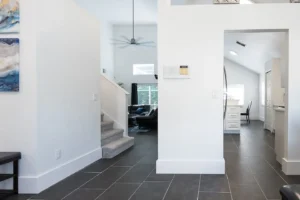Interior house painting has the power to completely transform the look and feel of a home. Whether you’re looking to update a room, create a new atmosphere, or simply freshen up the space, a fresh coat of paint can work wonders. In this article, we will explore the various ways in which interior painting can enhance your home’s aesthetic. From choosing the right colors to preparing your home for painting, we will cover all the essential steps to ensure a successful paint job. So grab your paintbrush and let’s get started!
Key Takeaways
- Interior house painting can transform your home and give it a fresh new look.
- Choosing the right colors is important and there are tips to help you select the perfect paint palette.
- Deciding between DIY and hiring a professional depends on your skill level and time constraints.
- Preparing your home for painting is crucial and involves steps such as cleaning and repairing surfaces.
- Using primer is important to ensure a smooth and long-lasting finish.
The Power of Paint: How Interior Painting Can Transform Your Home
The impact of interior painting on a home’s overall aesthetic cannot be overstated. A simple change in color can completely alter the mood and atmosphere of a room. For example, painting a room in light, neutral tones can make it feel more spacious and airy, while bold, vibrant colors can add energy and personality. Additionally, a fresh coat of paint can make a space feel cleaner and more updated, instantly giving it a modern look.
To truly understand the power of paint, let’s take a look at some before-and-after transformations. Imagine a dull, outdated living room with faded wallpaper and worn-out furniture. By simply painting the walls in a fresh, modern color and updating the furniture with new upholstery, the room is instantly transformed into a stylish and inviting space. The same goes for a drab bedroom that is brought to life with a coat of paint in a soothing color palette and some new bedding.
Choosing the Right Colors: Tips for Selecting the Perfect Paint Palette
When it comes to selecting the perfect paint palette for your home, there are several factors to consider. First and foremost, think about the mood or atmosphere you want to create in each room. For example, if you want your bedroom to be a peaceful sanctuary, opt for calming colors like soft blues or greens. On the other hand, if you want your living room to be a vibrant and energetic space, consider bold colors like red or yellow.
Another important consideration is how the colors will complement each other and the room’s decor. Take into account the existing furniture, flooring, and accessories in the room, and choose colors that will harmonize with these elements. For example, if you have a lot of warm-toned wood furniture, consider painting the walls in a complementary color like a cool gray or beige.
DIY vs. Hiring a Professional: Which Option is Right for You?
| Factors | DIY | Hiring a Professional |
|---|---|---|
| Cost | Less expensive | More expensive |
| Time | More time-consuming | Less time-consuming |
| Skill level required | Basic skills required | Advanced skills required |
| Quality of work | May not be as high | Professional quality |
| Risk of mistakes | Higher risk of mistakes | Lower risk of mistakes |
| Personal satisfaction | May be more satisfying | Less personal satisfaction |
When it comes to interior painting, one of the first decisions you’ll need to make is whether to tackle the project yourself or hire a professional. Both options have their pros and cons, so it’s important to consider your own skills, time availability, and budget before making a decision.
DIY painting can be a cost-effective option, as you won’t have to pay for labor costs. It can also be a rewarding experience, allowing you to take pride in completing a project on your own. However, it does require time and effort, as well as some basic painting skills. If you’re not confident in your abilities or don’t have the time to dedicate to the project, hiring a professional may be the better option.
Hiring a professional painter can ensure a high-quality finish and save you time and effort. Professionals have the necessary skills and experience to tackle even the most challenging paint jobs. However, it does come at a cost, as you’ll need to pay for labor and materials. It’s important to get multiple quotes from different painters and ask for references before making a decision.
Preparing Your Home for Painting: Steps to Take Before the Paintbrush Comes Out
Proper preparation is key to achieving a professional-looking finish when it comes to interior painting. Before you even pick up a paintbrush, there are several steps you’ll need to take to ensure a smooth and successful paint job.
First, clear the room of all furniture and accessories. This will not only make it easier to paint, but it will also protect your belongings from accidental spills or splatters. If you can’t remove all the furniture, be sure to cover it with plastic or drop cloths.
Next, clean the walls thoroughly to remove any dirt, dust, or grease. This will ensure that the paint adheres properly and results in a smooth finish. Use a mild detergent and warm water to clean the walls, and be sure to rinse them thoroughly.
After cleaning, inspect the walls for any imperfections such as cracks, holes, or peeling paint. Repair these issues using spackle or putty, and sand them down until they are smooth. This will create a clean and even surface for the paint to adhere to.
The Importance of Primer: Why Skipping this Step is a Mistake

One step that is often overlooked but is crucial to achieving a professional-looking finish is using primer before painting. Primer serves several purposes, including sealing the surface, providing a smooth base for the paint, and improving adhesion.
Using primer can help hide any imperfections on the walls, such as stains or patches. It also helps prevent the paint from soaking into the wall, resulting in better coverage and a more vibrant color. Additionally, primer can help the paint adhere better to the surface, ensuring that it lasts longer and doesn’t peel or chip.
Skipping the primer step can lead to poor results, such as uneven coverage, color bleed-through, and poor adhesion. It may also require more coats of paint to achieve the desired color and finish. While it may seem like an extra step that can be skipped, using primer is well worth the time and effort for a professional-looking result.
Painting Techniques: From Brushing to Rolling, Which Method is Best?
When it comes to painting, there are several techniques to choose from, each with its own pros and cons. The two most common techniques are brushing and rolling, but there are also options like spraying and sponging.
Brushing is the most traditional method of painting and is best suited for smaller areas or detailed work. It allows for more control and precision, making it ideal for cutting in around edges or painting trim. However, it can be time-consuming and may result in brush marks if not done properly.
Rolling, on the other hand, is a faster and more efficient method of painting larger areas. It provides a smooth and even finish and is great for walls and ceilings. However, it may not be as precise as brushing and can be more difficult to use in tight spaces or corners.
The best technique to use will depend on the specific surface and situation. For example, if you’re painting a textured wall, a roller may be the best option to ensure even coverage. If you’re painting trim or intricate details, a brush may be more suitable for the job. It’s important to experiment with different techniques and tools to find what works best for you.
Accent Walls: How to Make a Bold Statement with Paint
One popular trend in interior painting is the use of accent walls. An accent wall is a single wall in a room that is painted in a different color or pattern than the other walls. This technique can add interest and drama to a space, creating a focal point and making a bold statement.
When choosing an accent wall, consider the architecture of the room and any existing focal points. For example, if there is a fireplace or a large window in the room, consider painting the wall behind it as the accent wall. This will draw attention to these features and create a cohesive look.
In terms of color selection, choose a color that complements the other walls and decor in the room. It should be a shade that stands out but still harmonizes with the overall color scheme. Consider using a darker or bolder color than the other walls to create contrast and make the accent wall pop.
Painting Trim and Ceilings: Tips for a Professional-Looking Finish
When it comes to interior painting, it’s not just the walls that need attention. Painting trim and ceilings is equally important in achieving a professional-looking finish.
When painting trim, it’s important to use a smaller brush for precision and control. Take your time and use steady strokes to avoid drips or smudges. Be sure to tape off any adjacent surfaces to prevent paint from getting on them.
When painting ceilings, it’s best to use a roller with an extension pole for ease and efficiency. Start by cutting in around the edges with a brush, then use the roller to cover the rest of the surface. Be sure to work in small sections and blend each section into the next to avoid visible lines.
For both trim and ceilings, it’s important to choose the right type of paint. Trim paint should be durable and easy to clean, while ceiling paint should be formulated to resist stains and mildew. It’s also important to use a high-quality brush or roller for a smooth and even finish.
Eco-Friendly Painting: Choosing Non-Toxic Paints for Your Home
In recent years, there has been a growing demand for eco-friendly paints that are free from harmful chemicals and toxins. Traditional paints can release volatile organic compounds (VOCs) into the air, which can contribute to indoor air pollution and have negative health effects.
Choosing non-toxic paints is not only better for your health, but it’s also better for the environment. These paints are made from natural ingredients and have low or no VOC content, making them safer for you and your family.
When selecting eco-friendly paints, look for labels that indicate low or no VOC content. There are also certifications, such as Green Seal or LEED, that ensure the paint meets certain environmental standards. Additionally, consider using water-based paints instead of oil-based paints, as they tend to have lower VOC content.
Maintaining Your Newly Painted Walls: Tips for Long-Lasting Results
 Once you’ve completed your interior painting project, it’s important to properly maintain your newly painted walls to ensure they stay looking fresh and vibrant for years to come.
Once you’ve completed your interior painting project, it’s important to properly maintain your newly painted walls to ensure they stay looking fresh and vibrant for years to come.
Regular cleaning is key to maintaining painted walls. Use a soft cloth or sponge and a mild detergent to remove any dirt or stains. Avoid using abrasive cleaners or scrub brushes, as they can damage the paint.
In high-traffic areas or areas prone to stains, consider applying a clear topcoat or sealer to protect the paint. This will create a barrier that makes it easier to clean and prevents stains from penetrating the paint.
It’s also important to address any issues that may arise, such as chips or peeling paint. Touch up these areas as soon as possible to prevent further damage and maintain a seamless finish.
Interior painting has the power to transform your home and create a fresh and updated look. From choosing the right colors to preparing your home for painting, there are several steps to consider for a successful paint job. Whether you decide to tackle the project yourself or hire a professional, proper preparation and technique are key to achieving a professional-looking finish. So don’t be afraid to pick up a paintbrush and transform your home with the power of paint!
Looking to transform your home with a fresh coat of paint? Check out this informative article on interior house painting by Painter Near Me. Whether you’re in Orange County or anywhere else, their team of skilled professionals can help you achieve the look you desire. From choosing the right colors to prepping the walls and applying the paint, their house painter services are top-notch. Don’t miss out on this opportunity to learn more about their expertise in interior painting. house painter services to read the article and get inspired for your next home improvement project.
FAQs

What is interior house painting?
Interior house painting is the process of applying paint to the walls, ceilings, and other surfaces inside a house to improve its appearance and protect it from damage.
What are the benefits of interior house painting?
Interior house painting can improve the appearance of a home, increase its value, protect surfaces from damage, and create a more comfortable living environment.
What are the different types of paint used for interior house painting?
The most common types of paint used for interior house painting are latex, oil-based, and enamel. Each type has its own advantages and disadvantages, and the choice of paint will depend on the surface being painted and the desired finish.
What are the steps involved in interior house painting?
The steps involved in interior house painting include preparing the surfaces to be painted, choosing the right paint and tools, applying the paint, and cleaning up afterwards.
How long does interior house painting take?
The time it takes to complete an interior house painting project will depend on the size of the house, the number of rooms being painted, and the complexity of the job. A small room can be painted in a day, while a larger house may take several days or even weeks to complete.
Can I paint my own house?
Yes, it is possible to paint your own house, but it can be a time-consuming and challenging task. It is important to have the right tools and equipment, as well as the knowledge and skills to prepare surfaces, choose the right paint, and apply it correctly. Hiring a professional painter may be a better option for those who are not experienced in interior house painting.
Page design by Website Design and Marketing Near Me


